British Wild Orchids Gallery
Page 2
 Orchid Family
Orchid Family
Back to home page

Seven species of the genus Dactylorhiza. These are the so called "spotted" orchids which are often difficult to tell apart being quite variable in colour and having a tendency to hybridize freely! The habitat and general location in Britain can help with identification.
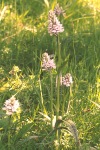
Common Spotted Orchid
The most widespread and common British orchid, the Common Spotted Orchid (Dactylorhiza fuchsii) has a preference for chalk and limestone grassland. Its leaves are always dark-spotted but the plant itself may be variable in height (as in the photo).
Taken at the National Pinetum, Cranbook, Kent at the end of May.
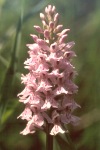

The flower spikes are 'dense' and the lip is prominently three-lobed. The colour of the flowers is normally dark to light pink with variable patterning on the lip but they normally have one to three purple loops either side of the lip centre line.
Rarely an albino may be found (second photo). An albino totally lacks pigmentation and should not be confused with white forms of normally coloured flowers. You can tell that the second specimen is albino by the white pollinia under the 'hood' of the flower - on normal (and white coloured forms) the pollinia are purple.
The first photo was taken at a Buckinghamshire nature reserve at the end of June; the second was taken at an Oxfordshire reserve in mid-June.
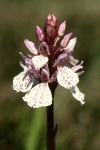
Heath Spotted Orchid
The Heath Spotted Orchid (Dactylorhiza maculata) replaces the Common Spotted in more acid, heathy regions. Its lip is broader with a less prominent tooth and the flowers are generally paler. Loops and other markings on its lip tend to be less well defined.
This orchid can colonise quite damp areas and there is a crossover with the 'Marsh' orchids of the Dactylorhiza genus.
Taken in Pembrokeshire, Wales towards the end of May.
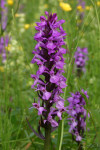
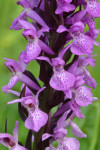
Southern Marsh Orchid
This orchid is widespread and locally common in southern England. It extends northwards to Manchester or so where it overlaps with the Northern Marsh Orchid. The Southern Marsh Orchid (Dactylorhiza praetermissa) favours damp or even marshy ground and can also be found in dune slacks. The leaves are usually unspotted. The flowers tend to be markedly 'pink' and have spots or short dashes on the lip rather than the bold continuous lines of the Common Spotted Orchid. The lip is broad and lacks the prominent central tooth of that species. The Southern Marsh hybridizes freely with the Common Spotted and Northern Marsh Orchids making identification sometimes tricky.
Taken at a Buckinghamshire SSSI site in mid-June.
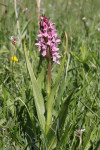

Early Marsh Orchid
Only found in damp/marshy calcareous grassland and similar dune slacks. Not particularly common and scarce in the far north. The leaves of the Early Marsh Orchid (Dactylorhiza incarnata) are lance-shaped, yellow-green and unspotted. The bracts (leaflets that grow along the flowering stem) are long and can noticably protrude beyond the flowers. The flowers tend to be pale pink, sometimes with a subtle yellow tinge and are characterised by their lips being folded backward making them look narrow when viewed from the front. Most authorities recognise four (or five!) subspecies which can merge into intermediate forms when present together.
Taken at a Buckinghamshire reserve in early June.
Not represented: Northern Marsh, Broad-leaved Marsh and Irish Marsh orchids
Back to Contents
Six species of the genus Orchis.
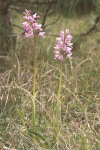
Military Orchid
The Military (or Soldier) Orchid (Orchis militaris) is extremely rare in Britain and is restricted to only a couple of sites in the Buckinghamshire Chilterns and Suffolk. The Military (and Monkey) Orchid was once common in the Chilterns but collecting and habitat destruction made it extinct in the 1920's. Some 20 years later it was rediscovered and has since grown in numbers year-on-year. This has come about through dedicated study of the plant, careful conservation of its surroundings and backbreaking manual fertilization of the flowers by the resident warden!
This shot was taken in the Causse Noir, near Milau, France, at the end of May.
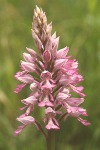

These close-ups show the pale lilac 'hood', formed by the sepals, which give the appearance of a military helmet that gave the flower its English name. Less distinct are the rows of purple 'tunic buttons' down the length of the lip that may have also influenced its name.
Both shots were taken at the Buckinghamshire reserve between the end of May and mid-June.
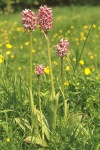
Monkey Orchid
The Monkey Orchid (Orchis simia) is a smaller plant than the Military Orchid both in statue and general build of the individual flowers. It is most unusual for British orchids in that its flowers open from the top-down rather than the other way around - however, its dense, almost spherical flower head can often mask this trait.
Another very rare species, the Monkey Orchid is restricted to three sites, one on the Chiltern Downs in Buckinghamshire, the other two in Kent.
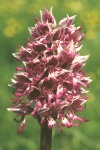
This shot illustrates the longer, thinner limbs of the flower and the more prominent 'tail' between its 'legs'.
The specimens of the two separated regions are quite different in appearance, the Buckinghamshire flowers being paler and the plants less robust. The Kent plants are more intense in colour and are more like their cousins in France. This has led to speculation that the Kent specimens are of a recent continental origin perhaps from seed blown across the English Channel.
Both photographs were taken at the 'open' Kent reserve at the end of May.
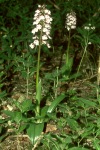
Lady Orchid
Locally common in Kent, the Lady Orchid (Orchis purpurea) can be found in quite dense woodland extending out into clearings. It can grow some two feet in height and the flower head may have up to 50 flowers.
On the continent the Military, Monkey and Lady Orchids hybridize freely and such hybrid swarms can be difficult to identify - although generally the flowers tend to show intermediate features of the contributing species. In Britain the species are well segregated geographically and the likelihood of hybridization is very remote.
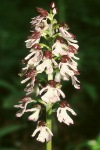
The 'hood' varies from almost black to dark red and the lip is predominantly white, flushed with pink, with a profusion of red/purple spots. It has the fanciful appearance of a lady dressed in a divided skirt.
Both shots were taken at a Kent nature reserve in late May.
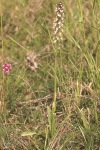
Burnt Orchid
The Burnt or Burnt-tip Orchid (Orchis ustulata) gets its name from its apparent burnt top of the flower head. This is readily evident in British specimens when tend to be smaller and the flower heads compact and semi-conical. The 'burnt' nature is not so obvious in the taller continental specimens such as the one here. This species has one of the longest life cycles of British orchids spending up to 15 years developing its rootstock before the first aerial leaf appears.
The orchid's distribution is restricted to a scattering of sites in southern England on chalk. The largest colonies are on the Wiltshire Downs.
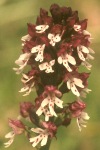
This close-up shows the delicate nature of the flowers. Some authorities claim that the flowers smell of stewed cherries but that has not been my experience.
Both shots were taken on the Causse Noir near Millau, France, at the end of May
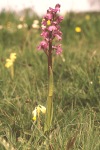
Green-winged Orchid
This orchid can be locally common in suitable, undisturbed, neutral or calcareous grassland. It is a relatively early flowerer and can dominate the scenery (the photograph shows it in the company of Cowslip but it is also associated with the Cuckoo Flower or Lady's Smock).
The flowers of the Green-winged or Green-veined Orchid (Orchis morio) are normally purple or pink but white specimens can be quite commonly found.
This shot was taken at a Buckinghamshire nature reserve at the beginning of May.
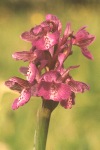
This shot, taken at a Worcestershire nature reserve in early May, clearly shows the green veins on its 'wings' that give the orchid its English name. The veins are even greener when viewed upwards from inside the flower.
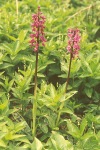
Early Purple Orchid
This is one of the most common orchids and can be found in most parts of the country in woods and grassland. The Early Purple Orchid (Orchis mascula) is the earliest orchid to flower, generally being April in the south and slightly later towards the north. Flowering can continue until the end of June. It generally has a prominent dark-blotched rosette of leaves at its base, a long purple stem ending in a spike of rich purple flowers (although they may be paler or even white).
This shot, taken at a Suffolk nature reserve at the beginning of May, shows it in the presence of Dog's Mercury, which is a plant characteristic of shady (often beech) woods that this orchid prefers.
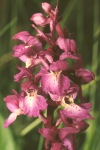
The flower of this orchid is mainly purple with a paler centre and sparse spotting of the lip becoming more concentrated at the throat of the flower. The sepals are thrown right back giving the flower a more open appearance.
This photograph was taken at the Malham National Nature Reserve, Yorkshire, at the end of May.
Back to Contents
Next page

Last revised: June 28th 2013
Home page: http://www.pnielsen.f2s.com/
Ó
Copyright Paul Nielsen 1997-2013
![]()













![]()